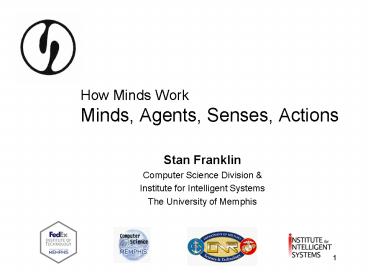How Minds Work Minds, Agents, Senses, Actions - PowerPoint PPT Presentation
1 / 24
Title:
How Minds Work Minds, Agents, Senses, Actions
Description:
Humans: sight, hearing, touch, smell. Other animals: Bats, dolphins echolocation ... The smell of smoke is an inference drawn from molecules in the air ... – PowerPoint PPT presentation
Number of Views:128
Avg rating:3.0/5.0
Title: How Minds Work Minds, Agents, Senses, Actions
1
How Minds WorkMinds, Agents, Senses, Actions
- Stan Franklin
- Computer Science Division
- Institute for Intelligent Systems
- The University of Memphis
2
Two Burning Questions for Me
- How do minds work?
- Human minds
- Animal minds
- Artificial Minds
- How to make smart software agents?
- Copy them after humans
3
Question How do minds work?What would an answer
be like?
- A framework within which to understand the
various mental processes about which one might
become curious. - My answer will take most of the semester.
4
What is a mind?
- A mind is a control structure for an autonomous
agent.
5
What is an autonomous agent?
- A system embedded in, and part of, an
environment, that - Senses its environment
- Acts on it
- Over time
- In pursuit of its own agenda
- So that its actions affect its future sensing
6
Examples of Autonomous Agents
- We humans
- Most (all?) animals
- Computer viruses
- Some mobile robots
- Autonomous software agents
- Some organizations
7
Environment?
- Physicalist assumption Theres a real world out
there - Cyberspace is part of the real world
- Artificial environments also exist
- Causality assumption Causality operates, i.e.,
the universe is lawful
8
Sense the environment?
- Humans sight, hearing, touch, smell
- Other animals
- Bats, dolphins echolocation
- Sharks electroreception
- Photo, mechano, chemo, electro, magneto reception
- Artificial senses, e.g. strings of characters
9
Spatially Sensitive Senses
- Sense organ movement produces apparent motion at
its surface - E.g. human visionpress eyeball
- Bacterium nutrient gradient sensing is not
spatially sensitive - Temperature sensing by a thermostat is not
spatially sensitive
10
Illusory Motion
11
Illusory Woman
- The apparent woman is produced by
- A potted plant
- A shelf
- A cat
- A wine glass
- A plate
- A clothesline
- A pair of stockings
12
We each create our own world
- There is no RED out there, only
wavelengths of light - There is no sound when the unattended tree falls
in the forest, only vibrations in the air - The smell of smoke is an inference drawn from
molecules in the air
13
Illusions of the senses tell us the truth about
perception
- For a website devoted to this proposition, go to
- http//www.michaelbach.de/ot/index.html
14
The only question there is!
- What do I do next?
- For any autonomous agent
- Cognition is in the service of action selection
- Everything else is a side effect
15
Its own agenda?
- Motivation must be built in
- Either by evolution or a designer
- Can be causally implemented as in a
thermostat - Implemented by feelings and emotions in humans
and other animals
16
Actions affect sensing?
- Structural coupling to its environment
- Sensors must be appropriate to needs
- Effectors must be appropriate to needs
- Effectors must change the environment
- Sensors must record those changes
17
Reactive Agents à la Sloman
18
Add Deliberation
19
Add Meta-Management
20
Primitives
- Every autonomous agent must come
equipped with - Primitive sensorssensory receptors
- Primitive effectorsmotor output
- Primitive motivatorsof some sort
- These primitives put fundamental limits on what
the agent can sense and do
21
Action Selection Paradigm of Mind
- Best viewed as degreed rather than as Boolean
- Aggregate rather than monolithic
- Enabled by disparate mechanisms
- Overriding task to produce the next action
- Operates on sensations to create information
- Reconstructs memories (prior information)
- Is implementable on machines
22
A Cognitive Theory of Everything
- Sensation
- Perception
- Feeling Emotion
- Working memory
- Episodic memory
- Consciousness
- Learning
- Deliberation
- Volition
- Automization
- Action Selection
- Problem solving
- Self
- Metacognition
23
Readings in Artificial Minds
- Action Selection Paradigm pp. 17-18
- Pandemonium Theory pp. 234-244
- Copycat Architecture pp. 347-362
- Schema Mechanism pp. 314-324
- Sparse Distributed Memory pp. 330-344
- Behavior Networks pp. 244-258
24
Email and Web Addresses
- Stan Franklin
- franklin_at_memphis.edu
- www.cs.memphis.edu/franklin
- Conscious Software Research Group
- www. csrg.memphis.edu/































